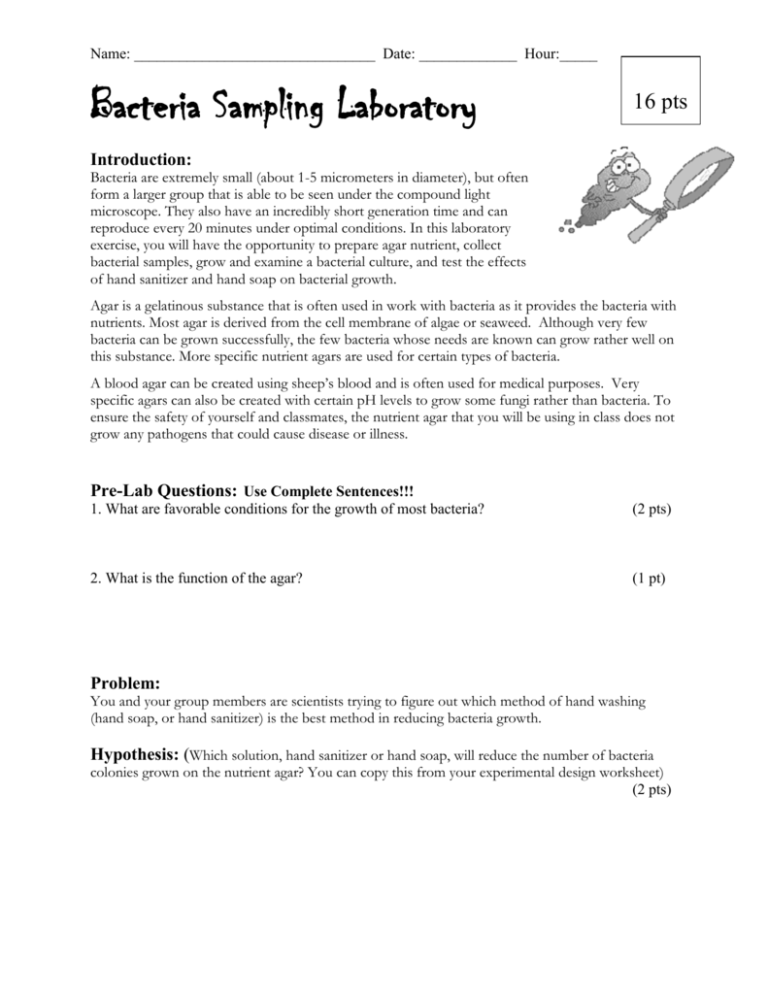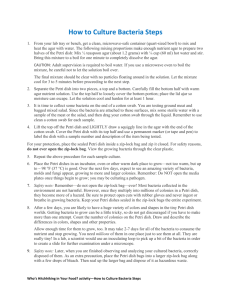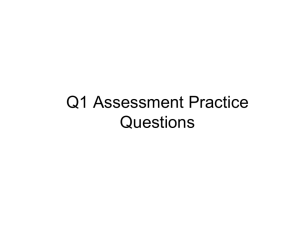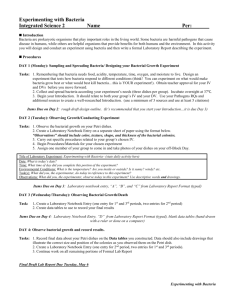Bacteria Sampling Lab: Hand Soap vs. Sanitizer
advertisement

Name: ________________________________ Date: _____________ Hour:_____ Bacteria Sampling Laboratory 16 pts Introduction: Bacteria are extremely small (about 1-5 micrometers in diameter), but often form a larger group that is able to be seen under the compound light microscope. They also have an incredibly short generation time and can reproduce every 20 minutes under optimal conditions. In this laboratory exercise, you will have the opportunity to prepare agar nutrient, collect bacterial samples, grow and examine a bacterial culture, and test the effects of hand sanitizer and hand soap on bacterial growth. Agar is a gelatinous substance that is often used in work with bacteria as it provides the bacteria with nutrients. Most agar is derived from the cell membrane of algae or seaweed. Although very few bacteria can be grown successfully, the few bacteria whose needs are known can grow rather well on this substance. More specific nutrient agars are used for certain types of bacteria. A blood agar can be created using sheep’s blood and is often used for medical purposes. Very specific agars can also be created with certain pH levels to grow some fungi rather than bacteria. To ensure the safety of yourself and classmates, the nutrient agar that you will be using in class does not grow any pathogens that could cause disease or illness. Pre-Lab Questions: Use Complete Sentences!!! 1. What are favorable conditions for the growth of most bacteria? (2 pts) 2. What is the function of the agar? (1 pt) Problem: You and your group members are scientists trying to figure out which method of hand washing (hand soap, or hand sanitizer) is the best method in reducing bacteria growth. Hypothesis: (Which solution, hand sanitizer or hand soap, will reduce the number of bacteria colonies grown on the nutrient agar? You can copy this from your experimental design worksheet) (2 pts) Materials: (If someone was to repeat your lab procedure, what materials would they have to use? Be specific in your list. You should list at least 8 materials for full credit.) (2 pts) Safety Tips for when you work with bacteria: Bacterial cultures can be very dangerous because they contain large numbers of living cells, some of which may be pathenogenic. Limit contact with the bacterial culture as much as possible. Clean your lab area after working with your bacterial culture. Dispose of the contaminated swab in a container of disinfectant. Do not lay swabs on the table or other surfaces because those surfaces would then have to be disinfected. Keep all Petri plates containing bacteria closed. Do NOT open them! Day 1: Bacteria Sampling Step 1: A swab is moistened with distilled water and a section of your sampling area is taken and rubbed across the agar in the section labeled H20. Care is taken to avoid gouging or tearing the surface of the agar and the Petri cover is replaced immediately. It is also important to prevent touching the swab to any other surface. The bottom of the Petri plates should already be marked with a sharpie so that it is known which section is which after the bacteria has grown. Throw the used swab away. Step 2: A new swab is moistened with the soap solution, rubbed across the sampling area, and then swabbed evenly over the area of the petri dish designated for the soap solution. The Petri cover is replaced immediately after each sample is taken and the used swab should be thrown away. Step 4: Using a new swab, repeat step 3 but this time dip the swab in the sanitizer solution before sampling your designated location. Step 5: Petri plates are sealed with clear masking tape and incubated at 37° C for 3 to 5 days with the cover side down. 1. Describe the function of the section of your petri dish with the water sample. (1 pt) 2. What could happen if the swab had touched more than just the sampling area? How could this affect the results? (1 pt) 3. Why is it important to use a different swab for each sample? (1 pt) 4. Why was it important to keep the Petri plates closed AFTER incubation? (1 pt) After 3-5 days in the incubator answer the following question: 5. Did you prove or disprove your hypothesis? Explain. (2 pts) Make a sketch of what your Petri dish looks life after being in the incubator. Be sure to label each section appropriately according to what it represents. (3 pts) Instructor Notes Sources: Heritage High School Teacher Generated Activity Influenced by: Science Company’s Bacterial Growth Experiments http://www.sciencecompany.com/sci-exper/petridishes.htm Additional Resources: Growing Bacteria in Petri Dishes by Steve Spangler Science; includes video and pictures. http://www.stevespanglerscience.com/experiment/00000165 Growing Bacteria In Vitro – Interactive Website http://virtuallaboratory.colorado.edu/Biofundamentals/labs/EColi%20introduced/section_02.html How to Grow Bacteria in Agar Petri Dishes Lab – Science Company http://secure.sciencecompany.com/How-To-Grow-Bacteria-in-Agar-Petri-Dishes-W54.aspx Michigan Content Expectations B1.1C Conduct scientific investigations using appropriate tools and techniques (e.g., selecting an instrument that measures the desired quantity—length, volume, weight, time interval, temperature—with the appropriate level of precision). B1.1E Describe a reason for a given conclusion using evidence from an investigation. B1.1g Use empirical evidence to explain and critique the reasoning used to draw a scientific conclusion or explanation. B1.1B Evaluate the uncertainties or validity of scientific conclusions using an understanding of sources of measurement error, the challenges of controlling variables, accuracy of data analysis, logic of argument, logic of experimental design, and/or the dependence on underlying assumptions. B2.4h Describe the structures of viruses and bacteria.









